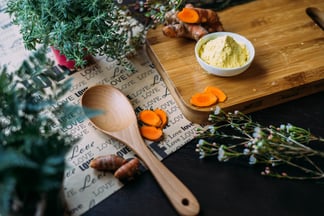Share this
Discover The Essentials Of Ayurveda And 3 Ways You Can Get Started!
by Victoria Sky on Jan 1, 2023 9:00:00 AM
Now I have never been a science geek, but I am a spirituality geek and for me, what Ayurveda does is combine the two, making it easy to find your optimum place of health and well-being which is suitable for your own unique individual DNA (doshically speaking).
This ancient science guides us on how to live in harmony with nature and its rhythms and cycles. When you live in tune with nature, you align with your unique human nature. That is where perfect health lies.
This wisdom can be practically applied to any living creature, wherever in the world they reside and whatever their life circumstances entail.
There are no rules in Ayurveda. It is based on principles which are there for each individual to take to their own unique life and apply in a way that is relevant to them.
Sounds easy.
It really can be when we uncouple from the fast food, fast-paced way of pushing through life.
Ayurveda comes from a Sanskrit word with two roots:
- Ayur means “life”.
- Veda means “knowledge” or “science”.
Thus, Ayurveda आयुर्वेद translates to “the science of life”.
 Ayurveda is part of the Veda – the body of that knowledge that governs the laws of nature, from which yoga, meditation, Ayurveda, Stapatyaveda (Vedic architecture), Jyotish (Vedic astrology) all come from.
Ayurveda is part of the Veda – the body of that knowledge that governs the laws of nature, from which yoga, meditation, Ayurveda, Stapatyaveda (Vedic architecture), Jyotish (Vedic astrology) all come from.
When we understand our unique combination of the elements (earth, fire, water, air and space) that create us and everything in nature, we can choose environments, food and practices which sustain our balance or bring us back to balance.
To live in harmony with nature, Ayurveda guides you to tune in and become aware of your own unique elemental makeup. In Ayurveda, there are three elemental types known as “doshas”:
- Vata: likened to autumn/winter - cold and dry. Your nervous system and body are dominated by air. (like a bird/butterfly)
- Pitta: likened to summer - hot, fiery, competitive and driven. (like a tiger)
- Kapha: likened to winter/spring - retaining water, easygoing, heavier set, mellow. (like an elephant)
At birth, you were most likely in perfect health. By applying the principles of Ayurveda, we can return to a state of natural health in alignment with our own special makeup of the doshas. One of the remarkable things about this way of living and eating is that you are unique, and by applying some simple principles and getting to know your rhythms, you can become your own healer.
Then you can live in peace with minimal to no suffering and radiate love and rich, inspiring radiance for all to enjoy.
Here are 3 easy ways to start:
- Three times a week, substitute one or two of your meals for a kitcheri dish
- Add a little 5-minute practice each day to your routine (a prayer before eating or maybe tongue scraping in the morning)
- Stock up on some Ayurvedic basics so that you feel new recipes or routines are accessible in the moment. – See the shopping list at the end of this blog.
If this has excited you, I have a free ebook guide complete with recipes and a 5-day free winter wellness home retreat package.
- Daily yoga and rituals
- Recipes
- Ayurvedic practices
- Evening meditations and sleep help
Get in touch directly or sign up here.
 As yogis, we have a little jump on the knowledge of the gunas (attributes) - Sattva (peaceful), Rajas (roaring light) and Tamas (inertia without light), each of us have our own unique blend of these three, which work with our dosha (how much butterfly/tiger or elephant we have in us) while ideally, we want to have more sattvic qualities in us.
As yogis, we have a little jump on the knowledge of the gunas (attributes) - Sattva (peaceful), Rajas (roaring light) and Tamas (inertia without light), each of us have our own unique blend of these three, which work with our dosha (how much butterfly/tiger or elephant we have in us) while ideally, we want to have more sattvic qualities in us.
Food, as well as the environment, can help us achieve this beautiful balance on the inside. You can recognise these qualities as you begin to enquire and notice your activities, food, and what you see around you.
Chilli’s, caffeine, and alcohol are seen as Rajasic foods that can aggravate the tiger in us. Hard cheese and white bread are seen as Tamasic foods that can encourage our elephant to snooze.
I hope this has ignited your curiosity about how you can be in optimum health using Ayurveda. I’d love to chat with you more about this, so please feel free to email or contact me via social media or on Yoga Alliance Professionals.
I want to leave you a few Sattvic foods to get you thinking. As we all live in different areas of the world, it’s essential to consider how far your food has travelled. E.g. if you are in England, apples are probably local, while dragon fruit isn’t. Stay local if you’re in any doubt about what to buy.
Fruits - apples, apricots, berries, dates (fresh), dragonfruit, figs, grapefruit, grapes with seeds, lychee, kiwifruit, mangoes, melons, nectarine, oranges, peaches, pears, persimmon, pineapple, plums, pomegranates, prunes, starfruit, tangerines (sweet), raisins
Legumes - adzuki beans, anasazi beans, black beans, black eyed peas, broad beans, brown lentils, cannellini beans, edamame beans, fava beans, green lentils, lima beans, mung beans, fresh snap peas, split mung beans, split peas
Nuts - almonds, brazil nuts, cashew nuts cooked, chestnuts, coconut, filberts, gingko, hazelnuts, macadamia nuts, pine nuts, walnuts, pecans, pistachio, tahini, tiger nuts
Oils - almond oil, coconut oil, flaxseed oil, ghee, macadamia nut oil, mustard seed oil, sesame oil, olive oil
Other - honey, maple syrup, raw milk, raw sugar cane, watercress, fresh wasabi, rose petals, lavender flowers, fresh almond milk, fresh rice milk, fresh coconut water
Spices - anise, basil, black pepper, brown mustard seeds, cardamom, carob, cilantro, cinnamon, cumin, coriander, dill, fennel, ginger, mint, lemon grass, sesame seeds, sorrel, turmeric, vanilla bean
Vegetables - artichokes, asparagus, bamboo shoots, beets, bitter gourd, bok choy, broccoli, brussel sprouts, burdock, cabbage, carrots, cauliflower, celeriac, celery, corn, courgette (zucchini), cucumbers, daikon, fennel bulb, flowers (edible), green beans, dark leafy greens, jerusalem artichoke, kohlrabi, lotus root, okra, parsnips, snow peas, spinach, summer squash, sweet potatoes, turnips (sweet), yacon, yams
Whole grains - amaranth, barley, rice (high quality, basmati, jasmine…), buckwheat, cornmeal, farro, kamut, millet, oats, quinoa, rye, spelt, teff, wheat, wild rice, fresh pasta, fresh noodles
 Sattva is that balance and state of peace (which whole foods, grains and leafy vegetables have too) Rajas is that fire of light within that can get agitated and frustrated (tomatoes, aubergines, coffee, alcohol)
Sattva is that balance and state of peace (which whole foods, grains and leafy vegetables have too) Rajas is that fire of light within that can get agitated and frustrated (tomatoes, aubergines, coffee, alcohol)
Shopping list of my essentials to get you started:
- Coconut oil
- Coriander seeds
- Cumin seeds
- Mustard seeds
- Ghee or butter to make ghee
- Rice
- Almonds
- Dates
- Fennel seeds
- Ajwan seeds
- Coriander powder
- Cardamom pods
- Cinnamon
- Fresh ginger
- Garlic
- Big sauce pan
- Chopping board
- Good knives for chopping and peeling
- Strainers (mini ones and big ones)
- Slow cooker or Rice cooker with a timer *not essential but handy if you are a busy person
- A grinder for nuts/seeds/rice, or there could be a function on your Nutri-bullet
- A blender
- Thermos big enough for soups or stews when you are out and about
- Tongue scraper
- Nasya Oil
- Neti - pot
- Oil to Abhyanga (coconut oil or dosha specific, which I can help you with)
Share this
- World Of Yoga (74)
- Teaching Yoga (64)
- Yoga Business & Marketing (38)
- Thinking Of Teaching (15)
- COVID-19 (6)
- Stress Awareness Month (5)
- Yoga For Men (5)
- Community (3)
- Online Presence (3)
- Pregnancy Yoga (3)
- Yoga Teacher Revolution (3)
- CPD Academy (2)
- Experience (2)
- Living The Yogic Life (2)
- Amrita (1)
- Anatomy (1)
- Asana (1)
- Discussions (1)
- Interview (1)
- Kids Yoga (1)
- Meditation (1)
- Mindset (1)
- Roots of Yoga (1)
- Standards (1)
- Traditional (1)
- Trainee (1)
- December 2025 (2)
- September 2025 (30)
- August 2025 (2)
- July 2025 (1)
- June 2025 (2)
- April 2025 (1)
- February 2025 (2)
- January 2025 (1)
- December 2024 (1)
- September 2024 (1)
- August 2024 (2)
- July 2024 (4)
- June 2024 (1)
- May 2024 (5)
- March 2024 (1)
- February 2024 (2)
- October 2023 (2)
- September 2023 (6)
- August 2023 (4)
- June 2023 (1)
- May 2023 (3)
- April 2023 (2)
- February 2023 (2)
- January 2023 (2)
- December 2022 (4)
- November 2022 (4)
- October 2022 (6)
- September 2022 (3)
- August 2022 (5)
- July 2022 (4)
- June 2022 (1)
- December 2021 (1)
- November 2021 (6)
- October 2021 (1)
- September 2021 (2)
- August 2021 (1)
- July 2021 (3)
- June 2021 (1)
- May 2021 (2)
- April 2021 (3)
- March 2021 (2)
- January 2021 (2)
- December 2020 (1)
- October 2020 (2)
- August 2020 (1)
- July 2020 (2)
- May 2020 (1)
- April 2020 (2)
- March 2020 (1)
- December 2019 (1)
- November 2019 (3)
- October 2019 (4)
- September 2019 (6)
- August 2019 (1)
- July 2019 (5)
- June 2019 (3)
- May 2019 (9)
- April 2019 (8)
- March 2019 (1)
- February 2019 (12)
- January 2019 (3)
- December 2018 (5)
- September 2018 (4)
- August 2018 (2)
- June 2018 (2)
- May 2018 (2)
- March 2018 (1)
- April 2017 (1)

No Comments Yet
Let us know what you think